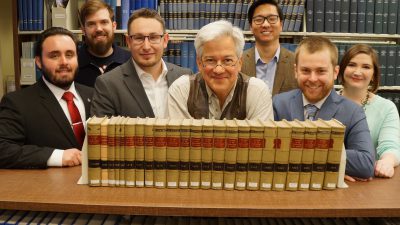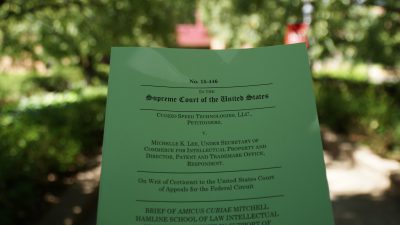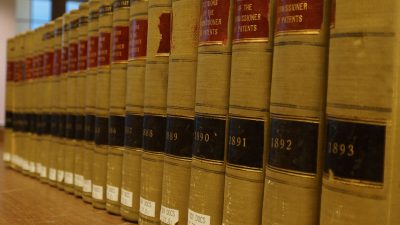A group of Mitchell Hamline students filed a legal brief in a patent case taken up by the U.S. Supreme Court in June, giving them a type of real-world experience available to only a handful of law students across the country.
The students were uniquely qualified to provide information to the court because of the school’s focus and expertise in teaching patent law and because they had access to patent decisions from the 1800s housed in the Warren E. Burger Library.
The students, all research assistants for Mitchell Hamline law professor Carl Moy, filed the brief in the case, Cuozzo Speed Technologies, LLC v. Lee, on Feb. 29.
The legal document goes by the Latin name “amicus curiae”, which translates as “friend of the court”. Amicus briefs are filed by parties who aren’t litigants in a case but feel the information they offer could be helpful as judges weigh their decisions.
“The main purpose of these is to assist the court,” said Moy. “We are in a unique position at Mitchell Hamline because as an academic institution we can look at these questions more deeply and from a larger systematic way.”
For Moy’s students, the brief was a chance to research, write, print, and publish a hardcopy legal document for nation’s highest court, all under an extremely tight deadline. The window to start and finish an amicus brief is only seven days long.
“You learn to work together as a team in very stressful circumstances,” Moy said. “Which is a critical skill if you’re going to be involved in litigation.”
Alex Gutnik, who will be a third-year student in the fall, said the work was stressful but provided invaluable experience.
“From contacting the parties, to forming the arguments, to making sure you have the periods at the end of a sentence, and eventually making these books and actually sending them to the correct parties and locations … it’s quite a process.” Gutnik said.
In the week they had to research and write the brief, Mitchell Hamline students spent long hours digging through century-old patent decisions in the Burger Library.
Karen Beckman, another rising 3L, said access to those documents provided key information for the brief.
“They’re very rare,” Beckman said. “Not a lot of schools have them, or law firms have access to them. We were able to dig back to the root source of where these decisions came from.”
The students’ amicus brief was one of the many documents Supreme Court justices had at their fingertips when making a decision in Cuozzo. The Court’s decision was released on June 21. It reaffirmed a United States Patent Office regulation that the Patent Trial and Appeal Board use the broadest reasonable interpretation, known as the BRI standard, in patent challenges.



